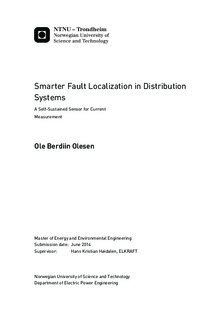Smarter Fault Localization in Distribution Systems: A Self-Sustained Sensor for Current Measurement
Master thesis
Permanent lenke
http://hdl.handle.net/11250/258060Utgivelsesdato
2014Metadata
Vis full innførselSamlinger
- Institutt for elkraftteknikk [2465]
Sammendrag
This thesis deals with the development of self-sustained sensors based on non-conventional measurement techniques. The motivation behind this topic is to help utility companies reduce their fault handling time and improve the way faults are handled. As of today, the distribution system does not have widespread surveillance and automation systems in place. The thesis therefore investigates a sensor design based on Rogowski coils (RC), with both measurement and power supply capabilities.The concept of printed-circuit-board Rogowski coils (PCB RC) and conventional RCs for current measurement is presented. A theoretical, dimensional study with respect to feasibility and output signal magnitude is then performed. On basis of this analysis, a PCB RC prototype is manufactured. For the sensor to be implemented in the resonance grounded distribution system, it must be able to measure currents of low magnitude, as the fault current is compensated by Petersen coils. The prototype is therefore tested for common distribution system current values. Due to limitations during construction and design flaws, the PCB RC performance was poor. The induced voltage error, with respect to the theoretical response was 64.3 - 69.1 %.As the prototype's ability to supply enough power to the sensor circuitry (demand found to be > 10 mW) proved so limited, a more thorough analysis concerning the RC is presented. Obtaining this amount of power is, theoretically possible and easier with a conventional RC. Its maximum average power supply capability was found to be 10.4 mW during ideal conditions. Even better results can probably be obtained as well. Based on this RC, the complete sensor system is discussed. This include rectification, digitizing, integration and boosting of the RC voltage to 3 V for battery application. A survey of possible fault localization methods for resonance grounded distribution systems is presented and an implementation is suggested.Finally, the prototype is tested with short circuit currents of 30 kA amplitude. The performance was better than for the load current test, but the magnitude error was still substantial. It varied from 20 % to 40 %. However, the lab's signal integration showed that the prototype reproduced the applied current waveform accurately.The simulations, testing and analysis performed indicate that a RC can be used for both supply of power and measurements. However, a prototype should be manufactured in order to assess this thesis' theoretical results. Combined with the proposed auxiliary circuitry and implementation strategy, it can improve the utility's fault handling.
